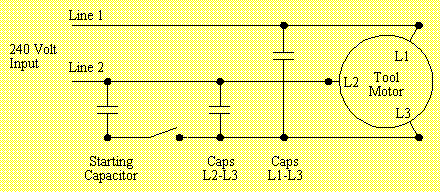Phase converters have been around for decades, transforming a single-phase power source into a 3-phase. The two most popular types of phase converters are:
Static Phase Converter typically consists of one or several capacitors and a relay switch. Rotary Phase Converter is the same Static Phase Converter only with a small idler motor (or generator) and run-capacitors, that give you a continuous 3-phase power while you use your equipment.
The main difference between Static and Rotary Phase Converters is that Static Phase Converter will disconnect itself after your engine has started and you will be left with 2 legs worth of power (which will not allow you to use the full HP rating of your equipment). On the other hand, Rotary Phase Converter will continue providing you with a three-phase power supply and you can use your equipment to the maximum of its capacity.
With many options of three-phase motors out there, now you don’t have to pass up a good deal if you don’t have 3-phase power coming into your shop. All you have to do is find the right phase converter that suits your needs and get working!
Static Phase Converters
Static Phase Converter is the simplest and cheapest way to start your 3-phase motor. It is mostly suited for medium to light size loads and single machine use.

They are not as expensive as other types of phase converters and are the easiest to wire. The only thing that you will have to give up is some of your horsepower.
This type of converter is not suitable for ALL motors, especially if they require full HP in order to work. It could be used for some machines if the motor’s pulley size is reduced in half or 1/3 in diameter.
Typical applications of Static Phase Converters include:
- Drills
- Grinders
- Mills
- Lathes
- Saws
- Conveyor Belts
- Irrigation pumps
- Sewing machines
- Vacuum pumps
- Ventilation systems
- Small Air compressors
- Metalworking Equipment
- Woodworking Equipment
- Printing Equipment
- Food Processing Equipment
- Food Mixers
- Food Blenders
For other uses, refer to the manufacturer of the equipment that you are considering buying. Regardless of how many times you have to call them, make sure that your equipment is compatible with that specific phase converter.
Sizing a Static Phase Converter
Before sizing a Static Phase converter, you need to figure out the following:
- Motor Winding. Static Phase Converters are primarily designed to work with Wye wound motors and this is how they give you 2/3 of power. If you use them with Delta wound motors, you will get only half of HP out of them.
- HP Rating. This is the simple one. Static Phase Converters generally need to match the HP rating on the nameplate of your motor.
Static Phase Converter variations
Static Phase Converter could actually be used as a base for different types of phase converters. Idler motor and Run capacitors could be added to your Static Phase converter.
Adding the Idler motor
In order to get your motor to full (or close to full) horsepower, you may want to consider adding a three-phase idler motor to generate the third leg of power. PHASE-A-MATIC™ gives you specific instructions (included here) on how to do that.
If you decide to use the idler motor-generator make sure that:
… its HP rating falls within converter’s HP range
This way, you can also run several machines at the same time, as long as the idler is large enough to handle the largest load. It is recommended for the idler motor to be:
… twice the size of the largest load
Just make sure that your Static Phase Converter has:
… same HP rating as to your idler motor, NOT your load
After your largest motor has started, you can start adding other motors, as long as:
… their combined HP does NOT exceed 1/2 of idler motor’s HP rating
Adding the Run capacitors
Here are some wiring diagrams with Static Phase Converter and Run capacitors:


Adding the Run capacitors and an Idler motor
Well, this variation is also known as Rotary Phase Converter (which will be discussed below). What is a Static Phase Converter? It is a system of start capacitors and a relay switch.
If you use Static Phase Converter or just start capacitors and wire them properly together with Idler motor, you will generate 3-phase power, just as a Rotary Phase Converter would!

Rotary Phase Converters vs Static Phase Converters
So what do we have here? Here are some pros and cons of Static and Rotary Phase Converters:
Why Static Phase Converter is better than Rotary
- It is less expensive
- It is easier to wire
Why Rotary Phase Converter is better than Static
- Rotary Phase Converter includes a system of start capacitors that works similar to Static Phase Converter.
- It does NOT drop the third leg and can power your motor up to 90% of their nameplate HP power (Static Phase Converter will only give you about 2/3).
In conclusion, I would like to mention that everything comes down to your load and how heavy you are planning to use your equipment. If you have a small to medium-size load and you are doing this as a hobby, the Static Phase Converter may suit your needs perfectly.
If you have a small enterprise, large machines, or a very busy shop, you may want to go with a Rotary model.
